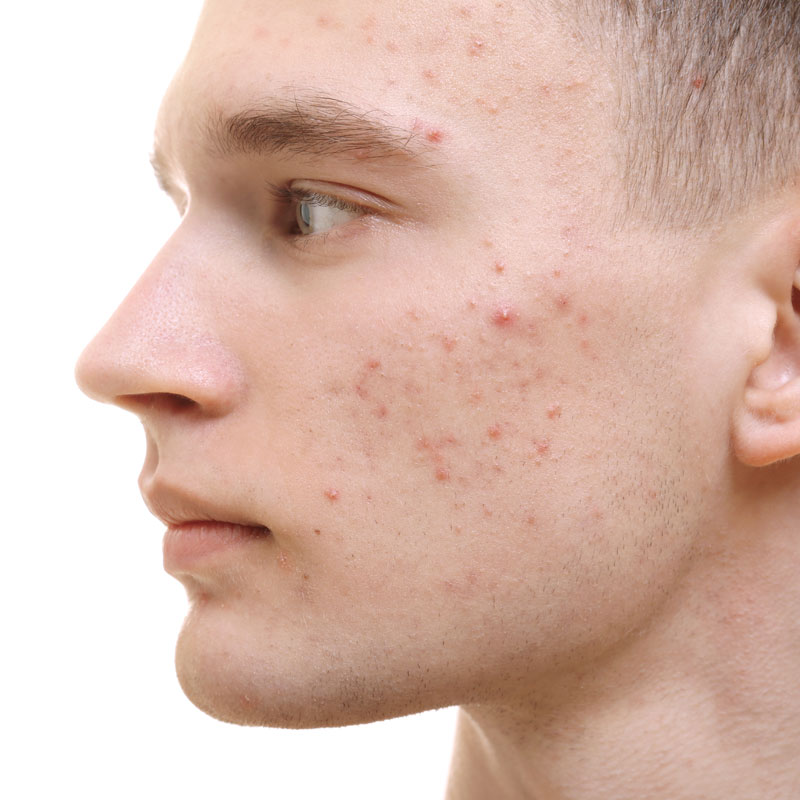Omaha Acne Treatment
As the most common skin condition in the United States, acne affects more than 50 million Americans each year. Though it is most often associated with adolescents and teenagers, acne can affect a wide range of ages from infants to adults. Unfortunately, there’s no one-treatment-cures-all when it comes to acne. Those with stubborn, severe, or recurrent acne typically find over-the-counter methods ineffective.
At MOD Dermatology, we work with our patients to provide the best possible acne treatment for their unique needs. Unlike the acne treatment provided by general practice physicians or popular over-the-counter treatments, we can create personalized plans for our patients based on extensive knowledge of the different types and causes of acne. From isotretinoin to light therapy to pimple creams, our Omaha-based skin clinic will help you find the right treatment for your skin type.
What is Acne?
Our skin is constantly regenerating, and in the process, dead skin cells rise to the surface of our pores and are shed from our skin. Yet, sometimes a naturally-occurring oil called sebum prevents this process from happening. When your body produces excess sebum, an oil that moisturizes your skin, it can cause skin cells to become trapped inside pores. If these clogged pores fill with the bacteria that lives on our skin (p. acnes), they can become inflamed, leading to acne. Acne can take many forms, such as blackheads and whiteheads (collectively known as comedones), cysts, pimples, nodules, and papules, and is most often found on the face, neck, chest, and back.

The Different Types of Acne:
Knowing what type of acne you have can help you choose the most effective treatment method. Here are the most common types of acne:
Comedones, commonly known as blackheads and whiteheads, appear when pores become clogged with oil, bacteria, and dead skin cells. If the pore closes up over the debris, you’ll see a whitehead. If the pore remains open, you’ll see a blackhead.
When the excess oil, bacteria, and dead skin cells that cause comedones push deeper into the skin and cause inflammation, papules will appear. This type of blemish is a small, red bump that feels hard.
Pustules are pus-filled blemishes. They’re a lot like papules, but pustules contain a yellowish fluid that gives them a yellow or white colored center.
Cysts appear deep into the skin and occur when the contents of comedones “spill” into surrounding skin. The body’s immune system responds by producing pus. They often look like large, red boils and can be painful.
Nodular acne remains intact deep under the skin. They can be skin colored and persist for weeks or even months. As a result, their contents sometimes harden into deep and stubborn cysts. Both cysts and nodules can leave permanent scars after healing.
ACNE TREATMENTS
When it comes to finding an effective acne treatment in Omaha, it’s important to understand that there is no single approach that works for everyone. What may work for a teenage girl with comedones may not work for a 35-year-old woman with cystic acne around her cheeks and chin. That’s why at MOD Dermatology in Omaha our acne treatment options allow you to personalize your treatment plan. Your dermatologist will work with you to find the acne treatment method that meets your individual needs.
Some of the most common acne treatments include the following:
- Topical creams and gels that target bacteria
- Prescription topical retinoids and comedolytics
- Oral or topical antibiotics
- Hormonal birth control pills
- Isotretinoin
- Chemical peels
- Extraction
- Light therapy
Common Acne Misconceptions
Misconceptions about acne are as common as the condition itself. Having a better understanding of acne, why it occurs, and how it’s prevented can help you find an effective treatment. Whether you require isotretinoin, light therapy, or pimple cream, our Omaha dermatologists will help you find the right mixture of treatments for you.
1. Acne Only Affects Teenagers.
Though acne is notorious for its relentless appearance during teenage years, acne can affect people of all ages. Newborns and adolescents can get acne, and adult acne, particularly amongst women, is on the rise. In fact, about 30% of acne starts in adulthood.
2. Washing Your Face More Will Cure Acne.
Though good hygiene is crucial for preventing acne breakouts, there are sometimes other factors that can cause stubborn acne, such as hormonal imbalances and excess sebum production. Washing your face more won’t guarantee clear skin; in fact, harsh scrubs can make breakouts and inflammation worse. It’s best to stick to washing your face twice daily with a gentle cleanser. Acne that isn’t going away with at-home treatment can often be treated with prescriptions or procedures recommended by your dermatologist.
3. You Have to Let Acne Run its Course.
Another common misconception is that acne, especially amongst teens, just has to run its course. However, early treatment can actually prevent acne from getting worse and can prevent permanent scarring, reducing the negative impact that acne can have on self-esteem and mental health.
Discover Effective, Personalized Acne Treatment in Omaha—Call MOD Dermatology of Omaha
Call 402-505-8777 to make an appointment today!




